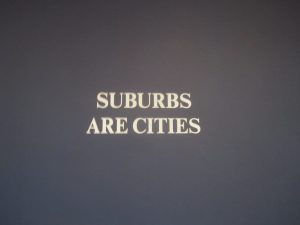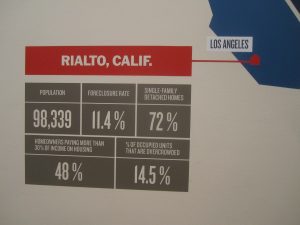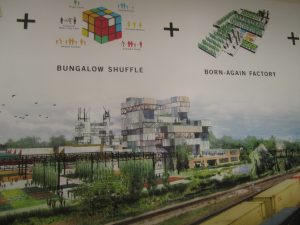By Roger Keil
A strange thing happened in the heart of the world’s most centralized global city. During the annual meetings of the Association of American Geographers (AAG) in New York City (February 24-28, 2012), suburban themes took centre stage. Remarkably, an unusual number of sessions presented research on suburbanization and suburbanism from around the globe. In fact, with a little added hyperbole, one could call this the first suburban AAG!
I cannot do justice to the wide array of work showcased at the meeting but I would like to point to a few of the many sessions. The program for the conference is still up and it will be possible for anyone reading this blog post to follow up with the authors/presenters directly for their papers and other communication.
 North American Suburbia Revisited
North American Suburbia Revisited
The conference started at 8am on Friday, February 24 (for me and others) with a reassessment of North American suburbanization. Jan Nijman of the University of Amsterdam, team-lead for the North American cluster in our Global Suburbanisms project, had assembled a group of veteran suburban researchers to revisit classic sites of suburbanization in the US and Canada. Roger Keil (York University) on Los Angeles; Elliot Siemiatycki, Jamie Peck and Elvin Wyly (UBC) on Vancouver; Paul Knox (Virginia Tech) on the new suburban ecology; Richard Walker (UC Berkeley) on the San Francisco Bay Area and Jan Nijman himself on Miami presented a tour de force of North American suburbia that challenged much of what we had previously taken for granted in this field of study. The suburbs portrayed here were not the ones we thought we knew from stereotypical TV representations and conventional suburban research. Strap on the seatbelts of the station wagon when these papers see publication (stand by on that one).
 Suburban Diversity in Frankfurt and Toronto
Suburban Diversity in Frankfurt and Toronto
In another session on the same day, organized by Monika Grubbauer (Darmstadt) on The Transnational Dimension of Contemporary Urban Development: Ideas, Trajectories, and Actors, Susanne Heeg, Bernd Belina, Christoph Mathias – (all of Goethe University Frankfurt) together with Ute Lehrer and Roger Keil (York University) presented preliminary work from their SSHRC sponsored comparative research project on policy options open to smaller suburban municipalities in the Frankfurt and Toronto regions. Their paper Finding competitiveness within: regional globalization in Frankfurt and Toronto proposed a first conceptual framework for the comparative study of Barrie and Markham in Southern Ontario, and Eschborn and Langenselbold in the Frankfurt-Rhine-Main region.
Suburbanism and the Future
Global Suburbanisms team members Markus Moos (Waterloo) and Alan Walks (Toronto) invited speakers from across North America and Europe to comment on their vision on the future of suburbs. In the abstract for the session, they proposed to “explore the future of suburbanism in a context when several of the factors facilitating post-war urban expansion are seemingly faltering. We ask about the ideologies behind contemporary urban development, and the way these tend to shape and re-shape existing patterns of socio-spatial inequalities. Is the post-war suburban development model truly under attack? What are the implications of alternative ideologies and urban growth models, and how are these shaping the future of suburbanism?” The stellar panel they assembled included next to the organizers Pierre Filion (Waterloo), Byron Miller (Calgary), Dirk Heinrichs (Berlin) and Per G Røe (Oslo). The speakers touched on various aspects of suburbanization in Europe, North America and Latin America.
 Contemporary North American Suburbanisms: Concepts and Metrics
Contemporary North American Suburbanisms: Concepts and Metrics
Pablo Mendez (UBC) and Markus Moos (Waterloo) organized a strong series of three well-attended sessions on the last day of the conference, Tuesday, February 28. The sessions were premised on the notion that the traditional suburb and traditional suburban studies had to be reevaluated in light of major socio-economic and socio-spatial change in a neoliberal era “forcing us to re-examine contemporary processes in the suburbs and our ways of mapping their development, consequences, and overall significance. Are we in need of new or re-worked concepts, research methods, and quantitative indicators to track and understand these socio-economic and spatial changes?” A very diverse group of speakers addressed these questions with new conceptual aplomb and a range of methodologies applied to a variety of case studies.
In the first session, Deirdre Pfeiffer (Arizona State) spoke about Racial Stratification in the Post-Civil Rights Suburbs? Christopher Niedt (Hofstra) addressed From Diverse Suburban Demographics to Diverse Suburban Politics to be followed by Liam McGuire (UBC) on Mapping the Megacity: Spatializing the Housing Issues of Immigrants in the Post-Fordist City of Toronto. The last paper in the session was by Mike Bulthuis (Ottawa) who examined Still the same story? Identifying a teenager's space in the suburb.
A second session started with a presentation on Mapping the idealized Canadian post-War suburb onto today's urban fabric by Moos and Mendez together with McGuire, Wyly and Robert Walter-Joseph (Waterloo). Alex Schafran (UCBerkeley) discussed Suburbia in context: Two methods for a relational suburbanism while Rob Fiedler (York University) examined Scarborella: reworking the postwar suburban boom. John Archer (Minnesota) proposed ways of Upending the Critique of Suburbia.
In a final session in this series on contemporary North American suburbanism, Ben Alan Gerlofs from Syracuse University gave a paper on Producing Edge City: Planning the Public on the New Frontier, to be followed by Joseph A Goddard of Aalborg University who presented on Penurbanizing America: the Outer Suburbs Redefined. Renaud Le Goix (University Paris 1 Pantheon-Sorbonne) read a paper co-authored by him and Elena Vesselinov (Queens College) on Inequality Shaping Processes and Gated Communities in US Western Metropolitan Areas. Kyle Shelton (University of Texas at Austin) concluded the suburban sessions with a paper on The Suburbs of the Urban Core: Recentering the Suburbanization of the Houston, Texas.
 Suburbs and densification: local resistances and dynamics of change
Suburbs and densification: local resistances and dynamics of change
While suburbs were the subject in the first time slot of the conference, they also featured big in the final period on Tuesday late afternoon. Organized by Eric Charmes (University of Lyon), four speakers addressed the relationship of Suburbs and densification: local resistances and dynamics of change. This session was designed to “analyze the confrontation between environmental and economic interests and local interests” and address the following questions: “How is densification carried out in the suburbs? Beyond the well-known NIMBY syndrome, how do residents react when confronted to the transformation of their surroundings? To what extent are they sensitive to the financial benefits they can extract from densification? On the contrary, how far are they ready to go to prevent any change in their living environment? How do local councilors articulate local demands with the national and regional policies promoting densification? At the metropolitan scale, how do densification policies reorganize the way cities are planned? How and why do some suburban areas get denser, while some others do not? Finally, what coalitions are formed for and against densification? How are the relations between public and private stakeholders transformed? “
Will Poppe presented a paper co-written with his York University colleague Doug Young Densification and Neighbourhood Renewal in Toronto's High-rise Suburbs. Anastasia Touati (LATTS - Ecole des Ponts Paris Tech) reported on Densification in the Paris low-rise suburbs: how and for whose profit? Max Rousseau (ENTPE) subsequently discussed Implementing densification at the metropolitan scale: the case of Lyon, France before Pierre Filion (Waterloo) ended the paper session with his presentation on Intensifying the Suburb: Lessons from Residential Densification Strategies in Toronto Suburbs (1945-2012). Roger Keil acted as discussant of the papers before Eric Charmes adjourned the session.
"Foreclosed: Rehousing the American Dream"
Caught in this and other streams of interesting sessions, I did not get out much to walk around Manhattan. But I was able to steal away for an hour to visit an exhibition at the Museum of Modern Art across the street from the conference venue. Quite appropriately, I thought, the MoMA is showing a very innovative exhibition called Foreclosed: Rehousing the American Dream. Open until July 30, 2012 this exhibition is well worth seeing. In 2011, the MoMA had asked five teams of architects to think through post-crisis and foreclosure ridden American communities across this suburban land. Their extremely striking analyses and designs are on display in this tight and very didactic show. (Some of the images in this post stem from this exhibit).
At the end of this suburban marathon, speakers discussed setting aside some time, perhaps an extra day, at the Los Angeles AAG meetings in April 2013 to speak about joint suburban research interests more intensely. Several of those present in New York also confirmed that they would seek acceptance at the Hofstra conference From the Outside In: Sustainable Futures for Global Cities and Suburbs in November.
Perhaps it is fitting that the AAG caravan moves to Los Angeles, often considered the most suburban of all American cities. One may even speculate that one day in the not too distant future, the AAG might consider recognizing the tremendous pull of global suburbanization and move the conference venue to the suburbs altogether. The growing interest to explore that aspect of urban geographies worldwide was clearly on full display in Manhattan in 2012. And as the wise man from Montreal once said, “first we take Manhattan, then we take the ‘burbs!”



Comment on “First we take Manhattan… and then we take the ‘burbs?”